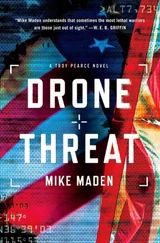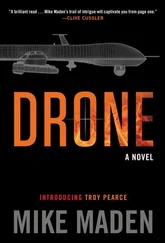The problem with that strategy, though, was that Bath and CIOS would undoubtedly be keeping a watchful eye on the Fieros. Ian had to find a way to disable CIOS without being detected so that he could exploit any breaches in the Fiero firewalls. But how?
Ian wasn’t confident he had the resources to deal with Bath. It reminded him of an exam he was once given in computational semiotics at Oxford. The tutor came into the lecture hall and demanded that each student come up with a question too difficult to answer—and then answer it. The entire room groaned with frustration and anger. It took Ian a few moments to realize the purpose of the exercise. People prefer the path of least resistance. People tend to work on problems they already know they can solve, thereby limiting intellectual growth. But avoiding problems that seemingly can’t be solved also limits intellectual growth because it means that people become increasingly unaware of what it is they don’t know. Science, in the end, is about knowing, and the beginning of “knowing” is finding out what you don’t know. Only by becoming aware of the impossibility of a problem—insufficient knowledge or skill—would possibilities for solutions begin to suggest themselves. And that’s when the first solution to Ian’s insoluble problem suggested itself.
Ian knew he wasn’t smart enough to overcome Bath, so he needed to draw on others for help. The international hacktivist community had been under assault by the national security agencies of Western governments throughout the world in the last two years. Whether through DDOS attacks, counterhacking, or just old-fashioned spycraft—honey traps, bribes, break-ins—agencies like the NSA and Britain’s GCHQ had crushed the backbone of many autonomous hacker groups. The surviving members were both afraid and eager for payback. Ian knew how to tap into their collective talent and rage.
Ian reached out to an old contact in the GCHQ who provided him with the necessary info. Carefully hidden behind a series of hijacked computers, Ian faked a new Edward Snowden leak, distributing the explosive “secret” that CIOS corporation and Bath had been the primary architects of the most recent antihacktivist campaign, along with a few IP addresses. This tiny nick put enough blood in the water to draw in the hacktivist sharks, and within hours a digital feeding frenzy had begun.
Within twenty-four hours of Ian’s launch, CIOS was fighting for its digital life, with Jasmine Bath leading the defenses. If Ian couldn’t disable CIOS and Bath, he could at least distract them long enough so that he could accomplish his second strategic objective—going after the Fieros.
Ian attacked the Fieros on two fronts with Myers’s help. First, he deployed one of Pearce Systems’ most reliable human assets, a redheaded Kiwi named Fiona York. As a former JTRIG operative specializing in physical operations, she was perfectly suited for what he had in mind.
York and an assistant picked up sixteen specially fitted miniature air and ground vehicles from Rao’s lab. Some of the MAVs deployed the same high-speed miniature cameras swallowed in pill form to photograph colons.
The MGVs were fitted with gecko-inspired microfiber pads that allowed them to climb walls or other vertical objects. Their primary objective was building and car windows. They were equipped with low-powered infrared beams that could “hear” the vibrations on glass caused by people speaking on the other side of them—a surveillance technique invented in the 1940s by the Russian Leon Theremin, inventor of the Theremin music synthesizer.
York deployed the miniatures with the help of a SmartBird drone, dropping them near the Fieros’ personal residences and vehicles in California and D.C.
But Ian’s main attack was cyber. It was only logical that CIOS would have put better security on the senator since she was their primary client and her home was geographically proximate to CIOS headquarters. Ian further surmised that Anthony Fiero didn’t want his vast financial empire exposed to Bath’s probing queries, which was yet another reason Ian decided to focus his efforts on him. That focus paid off quickly.
Ian knew that Fiero’s private company would have its own IT resources, separate from CIOS. A frontal assault on mainframes or hard drives was possible, but time-consuming. Better to attack on the periphery. Fortunately, that kind of attack was easier than ever these days, thanks to the “Internet of Things,” the machine-to-machine communication that facilitated more and more of modern life. Ten billion devices were connected now. By 2020, that number would rise to fifty billion.
Ian began by downloading the latest hacker list of known back doors to the top ten business software apps. Through one of those back doors, he gained access into an older version of Microsoft Outlook on the tablet of Anthony Fiero’s personal assistant. From that infection vector, Ian was able to make the leap into a variety of other Microsoft software programs, which then spread into the assistant’s laptop, then other devices and apps connecting the assistant’s laptop to Fiero’s laptop. Then the infection really spread.
Once inside Fiero’s laptop, Ian’s malware infected Fiero’s tablet, iPod, and even his Xbox One game system. The Xbox One Kinect feature provided Ian with voice and video images inside of Fiero’s home, which activated whenever the motion-activated Kinect system was triggered by his presence, recording everything he did or said in front of the gaming machine.
Automated software and data synching between machines and cell phone then spread the virus to Fiero’s phone, a treasure trove of data unto itself. A side benefit was that the phone infection spread to Fiero’s wireless Bluetooth connection, which, in turn, gave Ian access to Fiero’s car and its “smart” radio and GPS apps. Now Ian could listen in on or record any conversation Fiero had in his car through the radio and speakers, and geo-locate him even if Fiero’s phone wasn’t there.
The other significant penetration Ian achieved through Fiero’s phone was to invade the “smart” thermostat system Fiero deployed to remotely control his utilities when he was away from his home. Unfortunately for Fiero, the apps that controlled the smart thermostat also sent wireless data to the utility company, which in turn had access to Fiero’s bank accounts for automatic bill pay. Once Ian was inside Fiero’s bank account, he downloaded copies of all his financial transactions and acquired the personal data needed to find and penetrate other bank accounts, domestic and offshore, including those of his wife, who was also linked to those accounts. Those financial holdings were so vast, however, that Ian had to bring in a trusted consultant, a former Europol bank examiner who specialized in tracking down illicit Russian mafia drug money around the globe.
Ian also created several botnets exploiting the viral pathways now infecting almost all of the Fieros’ computer and computer-controlled devices, including Anthony’s newly installed “robo-toilet.” The botnets all went to work copying, downloading, or recording every sliver of data they could get their digital hands on. Like the NSA and its massive data-collection capabilities, however, Ian was overwhelmed with the sheer volume of data pouring in. It would take several days, maybe even weeks, for them to sort through it all and connect the dots. Myers had set about the analysis task immediately, while Ian kept expanding the data-collection nets. She was happy to let him take the lead on this operation. She had always been smart enough to delegate the hardest work to the most talented members of her team.
For all of their success, Ian thought the best news was that they had managed to slip their noses under the tent without Bath even knowing they were there. In a long string of personal achievements in the digital world, Ian couldn’t think of anything to top that.
Читать дальше












